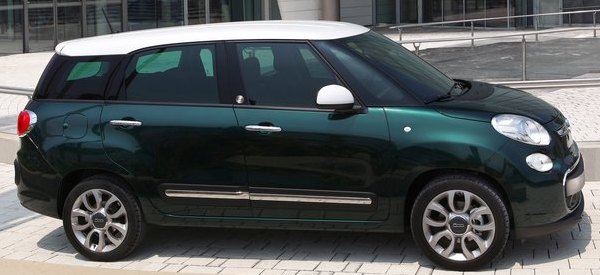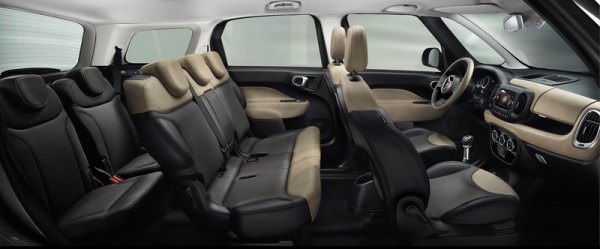|
|
FIAT 500L
|
 |
|
|
Debut: 2012
Maker: FIAT
Predecessor:
Idea
|
|
|
|
| Published
on 11
Jul
2012 |
All rights reserved.
|
|
|
Fiat's nameplates
are mostly misleading. Bravo is not so bravo; Panda is not as cute as
it sounds; Idea is not exactly a new idea. The latest addition to the
list is 500L, a car that sounds like a large version of 500 but is
actually a derivative of the Punto platform. It is just styled to give
a limited degree of relevance to the little 500.
The 500L succeeds Idea to be Fiat's B-segment compact MPV. It no longer
wants to sell on high practicality and value for money alone. Seeing
the success of BMW's Mini Countryman, the Italian thought maybe it
could inject a strong sense of style and fashion into the small MPV to
create a new icon. This should return a higher profit margin while keep
it save from the throat-cutting competition with Citroen C3 Picasso,
Opel Meriva, Toyota Verso-S (Ractis), Kia Venga and
Skoda Roomster. However, to create a new icon from clean sheet has
never been easy. It may take a lot of expensive marketing yet there is
no guarantee of positive reception. An easier way is to take advantage
of an established iconic nameplate, style it like an extension of that
car and people will get the idea immediately. Here comes the 500
nameplate.
The 500L has some resemblance to the 500 in its headlights and front
fascia, but their similarity stops there. The MPV is not only much
larger – a massive 600 mm longer, 160 mm wider, 180 mm taller and 312
mm longer in wheelbase – but it is shaped much squarer, contrasting to
the egg shape of the smaller car. Part of the squareness is due to the
need to maximize interior space. Less understandable is why it also
mixes the "squicle" theme of new Panda (see the wheel arches, front and
front bumpers and side stripes). The blackened pillars and wrap-around
glasshouse are also clear departure from the 500. Nevertheless, you can
still tell its common genes with the 500, not necessarily from its
limited shared features but probably from its strong emphasis on style,
in particular at the chroming on small details. Such a strong attention
to details is absent on other Fiat products bar the 500.
In the cabin, there is even less resemblance to the 500. The squicle
steering wheel comes from Panda despite of a classier finishing. The
instrument gets glowing backlit but otherwise it looks conventional –
no match with the 500's concentric dial for visual appeal. The
dashboard and center console are equally conventional. Hard plastics
are used everywhere, although you can customize the cabin with color
panels as in the 500, Mini or DS3. What this cabin really stands out is
practicality. Visibility is excellent all round thanks to the massive
glass area. A large panoramic
glass roof adds further to the airiness. The high and upright seating
arrangement in combination with 2612 mm wheelbase (that's 72 mm longer
than C3 Picasso's) result in a spacious interior for 4 adults. Rear
legroom is limousine-like if you slide the adjustable rear seat all the
way backward. Moreover, the wide cabin and a minimal central tunnel
allow the fifth passenger to sit with decent comfort.
To qualify as a 5-seat MPV, the car offers countless of storage cubbies
and a flexible cargo space. The 40/60-split rear seats can fold flat,
tumble forward, or slide back and forth to alter the distribution
between passenger and cargo space. At its foremost position, there is a
commanding 400 liters of luggage space. The front passenger seat can
fold to accommodate surf boards. The boot has a partition floor
adjustable to 3 different heights. On the equipment side, the funky MPV
offers classier options like a touch-screen multimedia system and
even a coffee maker!
Like many Fiat small cars preceding it, the 500L is far stronger at
packaging than driving dynamics. A cap on R&D spending means it has
to source most critical components from Punto, itself an old car
already. The platform is not particularly stiff or well insulated from
NVH by modern standards. Neither does its electrical power steering
deliver the best feedback and consistent weighting for its kind. More
problematic is the additional weight the MPV carries – about 100 kg
more than an equivalent Punto – and the high center of gravity it has
to bear, i.e. much beyond the level of the Punto component set can
withstand. The result is a driving dynamics that feels most at home in
town, where its light steering and soft suspension shine. Try to up the
pace on highway and you will find its performance is marginal, no
matter with which of the 3 engines. High-speed cruising is accompanied
with a floating ride and intrusive wind noise. Take a high-speed bend
and the car rolls alarmingly, while the steering feels wooden and
imprecise. What feels so nimble in town becomes unwieldy when you up
the pace.
Three engines are offered at launch. The 1.4-liter 16V FIRE used to
work brilliantly on the old Panda 100HP, but given 200 more kilograms
of load and a reduction of 5 horsepower to 95, this engine obviously
lacks bottom-end torque to cope with the car, even though it still
plays a sporty sound. Not a bad engine, but it just doesn't suit this
car. On the contrary, the 85 hp 1.3 Multijet turbo diesel is
satisfyingly torquey, offering more useable performance and lower fuel
consumption, but it takes 14 long seconds to go from 0-60 mph.
Theoretically, the range-topping 875cc TwinAir turbo is the best of
both worlds. Its output is lifted by 20 hp to 105 hp compare with the
existing unit on 500, Panda and Punto. This sounds more than enough to
compensate for the extra weight. In reality, the TwinAir is again
hampered by the lack of refinement – noisier and more vibration than
the four-cylinders – and a real-world economy falling a long way behind
its claim. It does offer the strongest mid-range punch from 2000 rpm
upward, but it does not suit the frequent start-stop pattern of town
driving.
Judging from its cute looks, roomy cabin and versatile packaging, I
would like to love the 500L. Unfortunately, it has serious shortcomings
in performance, handling and even driving refinement. This mean it
still fails to match Citroen C3 Picasso in the sea of affordable
compact MPVs.
|
Verdict:    |
| Published
on 18
Jul
2013 |
All rights reserved.
|
|
500L Living
|
|

|
Nearly 60 years ago Fiat
pioneered the concept of mini-MPV with 600
Multipla. It magically packed 3 rows of seats in a body measuring
only 3.4 meters long. Today's 500L Living isn't quite as compact. It is
920 mm longer than the old car, 330 mm wider and runs a wheelbase 600
mm longer. Despite that, it is the smallest 7-seater available today.
While all rivals ride on C-segment or larger platforms, the Fiat
employs a smaller B-segment platform. This should give it some
advantages in costs but there are also many compromises. One of which
is the 2612 mm wheelbase, i.e. identical to the standard 500L's because
it is already the maximum limit of the platform. The Living has to
extend the rear overhang to accommodate a pair of extra seats, yet the
latter are only large enough to seat children. In fact, the third row
is optional. Without them, you get a huge luggage space of 638 liters
with 5 seats in place. With them fitted, you can still fold them flat
onto the floor to place larger cargos. Unfortunately, the extension of
length does hurt the looks, which has lost the funky style of the
standard car.

|
Carrying an extra 50 kilos, the standard car's mediocre
performance is even more marginal. Not even the most powerful &
torquey 1.6 Multijet turbo diesel with 105 hp and 236 lbft can provide
brisk performance. It accelerates from rest to 60 mph at over 11
seconds and flat out at 112 mph. To many family drivers, that might be
more than adequate, but smaller engines will struggle to keep them
happy on motorway when overtaking is required. There is decent body
control for such a tall car – actually better than the standard car –
while ride quality is firm but not uncomfortable, thanks to the Koni
frequency selective dampers which switch to hard damping for low
frequency excitation (i.e. cornering) or soft damping for higher
frequency ones (e.g. running over undulations). However, it doesn't
change the fact that the car is dull to drive. The steering is numb and
imprecise, and the powertrain lacks sparkle. It seems that the further
the car is expanded, the less magic of the Fiat 500 remains.
|
Verdict:   |
|
|
|
|
|
|
|
|
|
|
500L 1.3 Multijet
|
2012
|
| Front-engined,
FWD |
| Steel monocoque |
| Mainly steel |
| 4147 / 1784 / 1665 mm |
| 2612 mm |
Inline-4, diesel
|
| 1248 cc |
DOHC 16 valves
|
VTG turbo
|
CDI
|
| 85 hp |
| 147 lbft |
| 5-speed manual |
F: strut
R: torsion-beam
|
| - |
| 205/55R16 |
1315 kg
|
| 102 mph (c) |
14 (est)
|
| - |
|
500L 1.4 16V
|
2012
|
| Front-engined,
FWD |
| Steel monocoque |
| Mainly steel |
| 4147 / 1784 / 1665 mm |
| 2612 mm |
Inline-4
|
| 1368 cc |
DOHC 16 valves
|
-
|
-
|
| 95 hp |
| 94 lbft |
| 6-speed manual |
F: strut
R: torsion-beam
|
| - |
| 205/55R16 |
1245 kg
|
| 106 mph (c) |
12 (est)
|
| - |
|
500L TwinAir
|
2012
|
| Front-engined,
FWD |
| Steel monocoque |
| Mainly steel |
| 4147 / 1784 / 1665 mm |
| 2612 mm |
Inline-2
|
| 875 cc |
DOHC 8 valves, VVT+VVL
|
Turbo
|
-
|
| 105 hp |
| 107 lbft |
| 6-speed manual |
F: strut
R: torsion-beam
|
| - |
| 205/55R16 |
1260 kg
|
| 112 mph (c) |
11.5 (est)
|
| - |
|
|
|
|
|
Performance
tested by: -
|
|
|
|
|
|
|
500L 1.4 Turbo (US)
|
2013
(2016)
|
| Front-engined,
FWD |
| Steel monocoque |
| Mainly steel |
| 4147 / 1784 / 1665 mm |
| 2612 mm |
Inline-4
|
| 1368 cc |
SOHC 16 valves, VVT+VVL
|
-
|
-
|
| 160 hp |
| 184 lbft |
6-speed manual or 6-speed twin-clutch
(6-speed auto)
|
F: strut
R: torsion-beam
|
| - |
| 205/55R16 |
1453 kg
|
124 mph (c)
|
6M: 8.7*; 6DCT: 9.1*
(6A: 8.0*)
|
6M: 25.2*; 6DCT: 25.1*
(6A: 23.9*)
|
|
500L Living 1.6 Multijet
|
2013
|
| Front-engined,
FWD |
| Steel monocoque |
| Mainly steel |
| 4352 / 1784 / 1667 mm |
| 2612 mm |
Inline-4, diesel
|
| 1598 cc |
DOHC 16 valves
|
VTG turbo
|
CDI
|
| 105 hp |
| 236 lbft |
6-speed manual
|
F: strut
R: torsion-beam
|
| Mechanical adaptive |
| 205/55R16 |
1410 kg (est)
|
| 112 mph (c) |
11.5 (est)
|
-
|
|
|
|
|
|
|
| Performance
tested by: *C&D |
|
|
|
|
|
|
|
|
Copyright©
1997-2016
by Mark Wan @ AutoZine
|
|